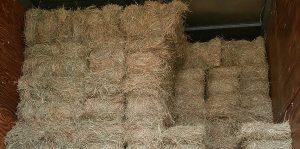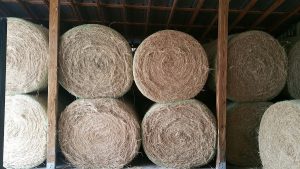

The question often asked, is which hay is cheaper to feed? Well that depends. The easy answer is divide the purchase price of the square bale and divide that cost by the pound weight of the bale. The result is the cost per pound of hay. Do the same calculation for the round bale and compare the $/pound. But, we feed hay to provide nutrients and fiber. So a higher quality hay might cost more per pound but supply more nutrients. In this case, it actually cost less per pound of nutrient supplied. Forage testing by a reputable lab is the only way to accurately determine nutrient content.
The forage growing in a particular field, and treated the same, is the same on any given day. It makes no difference whether it is cut, dried and baled into round bales or square bales. Round versus square baling is a function of the storage, transportation and handling processes. If both round and square bales are treated properly, then the quality should be close to identical. When purchasing hay from a feed store, one does not usually know how much bales weigh or where they came from. One also does not know how many different fields are represented or how the field was managed (cutting interval, fertilization program, herbicides used). So, without a forage test, it is very difficult to compare hay.
Another cost to consider is when feeding hay is “quantity fed.” With square bales, it is easy to portion out how much animals get. When feeding round bales, generally animals eat it until it is gone. So, an animal that requires 15 pounds of fiber per day, might actually consume 20 pounds/head/day. Let’s assume that both the square and round baled hay costs .157 $/lb. An animal that eats 15 pounds of hay/day or $2.35/day. By eating an extra 5 pounds the costs becomes $3.14/day, on a monthly basis, $23.55 in additional cost. A continuous supply, in the case of horses, means they won’t be eating your barn down or stripping bark off of trees.
Most quality round bales are now stored in barns too, to alleviate wastage due to weather. However unless the round bale is fed in a trough of some type of containment equipment (hay ring), a percentage of will be wasted due to trampling and manure contamination and will not be eaten.
So which is cheaper to feed? Well that depends on your management. To learn more regarding hay or forage quality go to: http://edis.ifas.ufl.edu/pdffiles/AG/AG16100.pdf
 0
0
